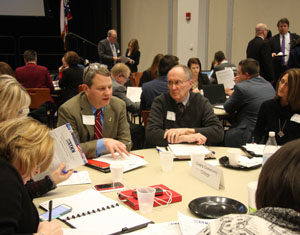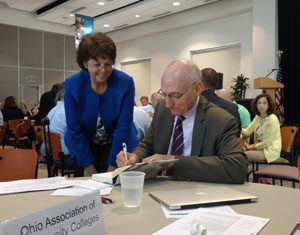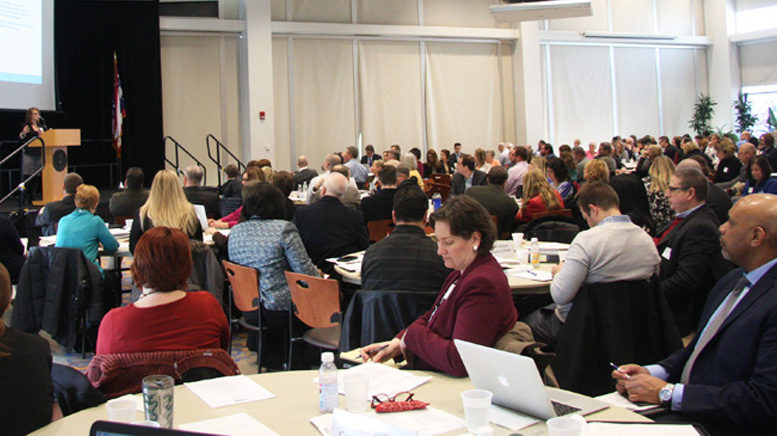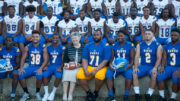When Ohio passed a law requiring every community college to develop and implement a completion plan – showing how they plan to improve student outcomes – the Ohio Association of Community Colleges (OACC) offered a helping hand.
The association’s Student Success Center launched a leadership institute in 2015 that periodically brings together teams from each of the state’s 23 community colleges to help them determine which reforms to work on – such as developmental education or guided pathways – and how to put them in place.
OACC President Jack Hershey and leaders of several colleges will give a presentation on Ohio’s statewide Student Success Leadership Institute (SSLI) at the American Association of Community Colleges’ (AACC) annual conference in New Orleans April 22-25.
At the SSLI, college teams have an opportunity to learn success strategies from college leaders on the front line who have been engaged in AACC’s Pathways Project, Completion by Design and Achieving the Dream and from national experts at the Community College Research Center and the National Center for Inquiry and Improvement.
When Ohio adopted a college system that is 100 percent based on outcomes, “there was a desire that all colleges share an opportunity to have access to the best research,” Hershey says.
Each college brings a team to the SSLI, including such participants as the president, vice president of academic affairs, dean of arts and sciences, dean of student services, academic advisers, institutional researcher, registrar, director of student success and faculty members.
“We’ve been very intentional about having colleges share their work with others,” says Laura Rittner, head of OACC’s Student Success Center.
Various parts
The association also implemented a coaching strategy that pairs colleges that have implemented successful reforms – in developmental education, advising and other areas – with colleges not as far along.
“Guided pathways is the cornerstone of this initiative,” Hershey says, and reforming remediation is also a big part of it.

A team from Owens Community College discusses student success strategies at a leadership institute. (Photo: OACC)
The college completion plans were due last June, Rittner says. Now the OACC initiative is helping colleges implement the plans, through coaching and workshops. Next year, the colleges will update their plans based on evidence about what’s working.
A key step in the process is the formation of data teams at colleges, Hershey says, because “so much of this reform requires colleges to understand data and be able to communicate the data across the campus.”
“Rising stars from institutional research departments or ATD” have been assigned to work with one to three colleges to help them build capacity working with data, he says.
CCRC is doing research to support this effort, Rittner adds, and OACC is working with the Ohio Department of Higher Education to pull key performance data so “we can more quickly assess whether we’re moving in the right direction.”
Guided Pathways
As a result of its work with the SSLI, Clark State Community College is implementing several initiatives, including guided pathways, says President Jo Blondin. The goal is to ensure that students are on the right path from the start, and to guide them onto alternative pathways when they are not accepted into a program with selective admissions, such as registered nursing.
The college has also grouped all of its academic programs into 10 career clusters to ensure that students take the right courses to complete a degree or certificate, and it has designed stackable certificates for students so they can attain that first credential.
Additionally, Blondin says, Clark State has redesigned its developmental education courses for occupational programs using the I-BEST (Integrated Basic Education and Skills Training) model.
The college has already shown some improvements in student outcomes, including increases in course completion and a decrease in overall credit hours that students take to graduate.
Data coaches
Central Ohio Technical College (COTC) decided to focus on retention after learning about retention strategies and resources from national speakers at the SSLI sessions, says Lauri White, vice president of academic affairs.
To address the problem of students not coming back after their first year, the college provided more training to advisers and implemented mandatory advising for all new students in their first semester. That will allow the college to start tracking whether students who had the benefit of face-to-face advising are ultimately more successful than those who registered online.
Let VFA help you: More than 90 percent of community college leaders say it’s important for community colleges to have a consistent national system of accountability. That’s where the AACC Voluntary Framework of Accountability comes in.
COTC also used data to realign the master schedule. By no longer scheduling required courses in the same time slot and cutting low-enrolled sections, the college hopes to improve its completion rate.
The opportunity to work with a data coach was a big advantage for COTC, White says.
“The coach allowed us to ask the hard questions that you don’t want to ask your colleagues,” she says. For example, “Why are a percentage of students not successful in a college-level course?” The data helped identify the “bottle-neck courses” and sections of courses that students are having the most trouble getting through.
COTC has adopted a co-requisite model with students taking developmental math and college-level math at the same time. That will start in this fall with statistics, White says. Co-requisite English courses are expected to be implemented in the 2018-19 academic year.
Sharing knowledge
The SSLI was especially helpful to small rural colleges that don’t have the resources to bring in nationally known experts to help them implement pathways, says Kevin Boys, president of Southern State Community College (SSCC).
“By coming together with all the colleges in Ohio, we are learning from other colleges’ teams. This has brought down some of those barriers. There is more communication going on across the campus,” Boys says.
For example, SSCC leaders have long been aware of the value of adopting reforms, such as co-requisite remediation, but that hasn’t filtered down, he says. It wasn’t gaining momentum until some of the other departments saw the value in it.
The English department now plans to implement a pilot in co-requisite remediation next fall, and the math department plans to follow soon after.

Thomas Bailey of the Community College Research Center signs a book at a leadership institute convened by the Ohio Association of Community Colleges. (Photo: OACC)
Boys used to have the idea that “implementing pathways was as simple as putting together a chart telling students what courses to take to meet their goal.” Now he understands it’s about a lot of things that have to work together, including intense counseling at both the beginning and end of a student’s time in college.
“We’re on the right track for implementing several components of guided pathways,” Boys says.
Career counseling and coaching have been strengthened, with advisers now taking students through a comprehensive inventory at their first meeting. SSCC is looking at meta majors and has begun mapping out course sequences in certain areas, such as health sciences.
Establishing meta majors is going to be difficult due to scheduling challenges, Boys acknowledges. SSCC’s campuses are small and most students attend part time, so the college can’t offer courses consistently due to low enrollment. One solution might be telecommunications options, with a course offered to all campuses through distance learning.
Another challenge is ensuring the data apply to dual-enrollment students, who comprise 43 percent of SSCC’s head count. Even if those students are headed to four-year institution, “we still want to make sure they are on a pathway to a bachelor’s degree,” he says.





